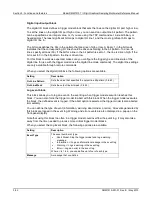
Section 3: Functions and features
Model DMM7510 7½ Digit Graphical Sampling Multimeter Reference Manual
3-72
DMM7510-901-01 Rev. B / May 2015
Using trigger timers with timing blocks
For precise timing or if you need to synchronize timing with other execution blocks or events, you can
use the SCPI or TSP trigger timer commands with trigger model wait blocks and notify blocks. You
can use the trigger timer commands to add small precise delays or to start measurements or to
overcome variable measurement delays. The Model DMM7510 has 1 to 4 independent timers.
For example, you can use a trigger timer to control the delay between non-sequential blocks. After
creating a trigger timer, you can insert a notify block to start the timer at a specific point in the trigger
model. You could then add a wait block to wait for the timer to expire.
Another example is a measure block that takes a variable amount of time. To ensure a precise time
between measurements, you can create a trigger timer and define it to be a fixed interval that is
longer than the longest possible measurement. Then you can set up the trigger model to include:
•
A notify block that starts the trigger timer
•
A measure block that makes a measurement
•
A wait block that waits for the timer to expire
•
A branch counter block that iterates some number of times
Some attributes of trigger timers should not be used with the trigger model. Attributes you should not
set are:
Count value of 0 (resulting in generation of trigger events indefinitely)
Delay lists
Remote trigger timer commands
SCPI trigger timer commands:
•
(on page 6-234)
•
(on page 6-235)
•
(on page 6-237)
•
:TRIGger:TIMer<n>:STARt:FRACtional
(on page 6-237)
•
:TRIGger:TIMer<n>:STARt:GENerate
(on page 6-238)
•
:TRIGger:TIMer<n>:STARt:OVERrun?
(on page 6-239)
•
:TRIGger:TIMer<n>:STARt:SEConds
(on page 6-240)
•
:TRIGger:TIMer<n>:STARt:STIMulus
(on page 6-241)
•
(on page 6-242)
















































